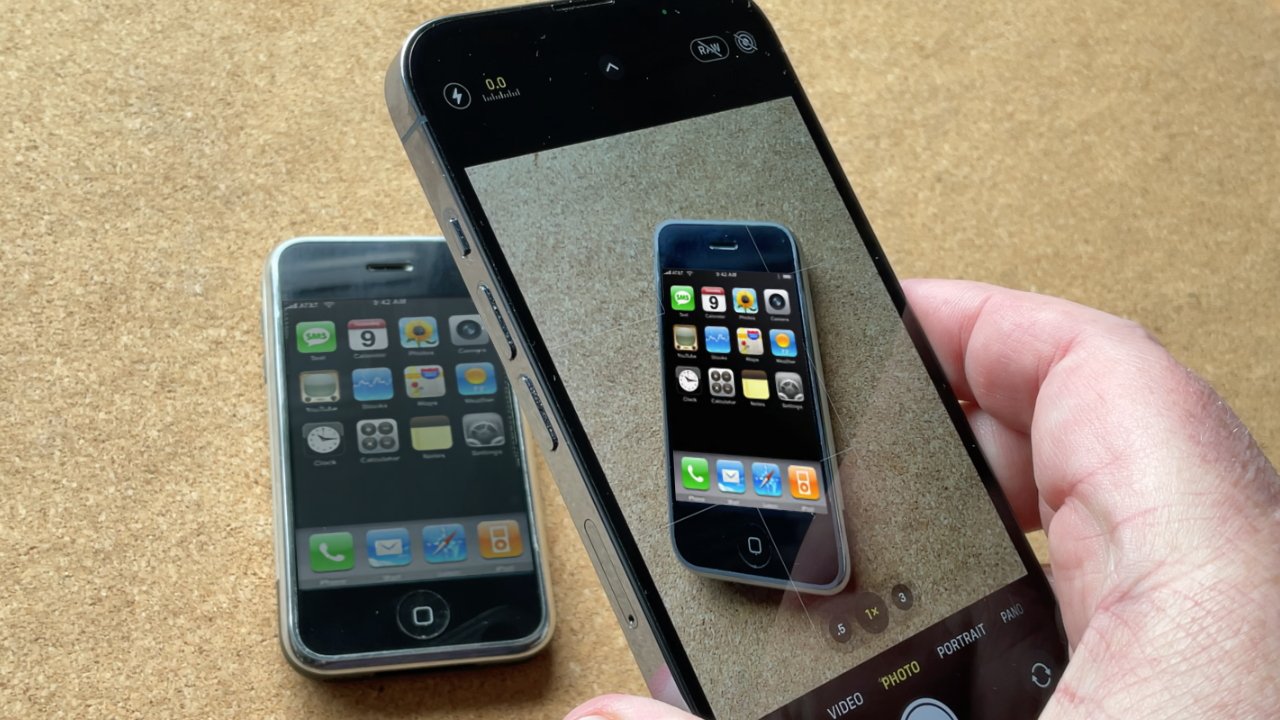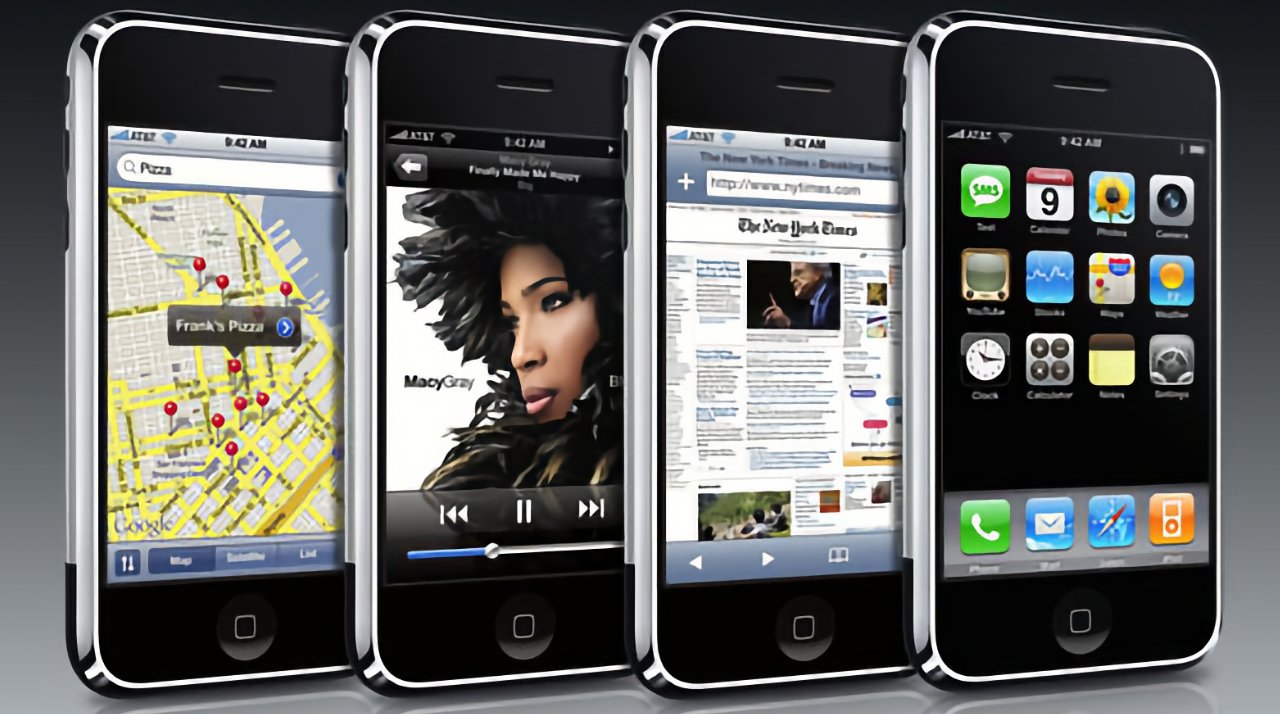Apple's iPhone came out 16 years ago and changed the world
Compared to today's iPhone 14 Pro and the upcoming iPhone 15, the very first iPhone that went on sale 16 years ago today was startlingly slow and incredibly limited — yet it changed the world.
It was on June 29, 2007, that the original iPhone went on sale in the US, and arguably that was the day that it truly began shaking up what users expected from a phone.
We and the phone industry had already known all about it for over five months. But it wasn't until you could buy it that the impact of this little device began to be felt — even inside Apple.
"[Going on sale] is a happy moment, but it's also a stressful one," Apple's Tony Fadell told the Wall Street Journal for a video released in 2022. "What's going to happen when it goes out into the world?"
"It was amazing," said Greg Joswiak, now senior vice president of worldwide marketing at Apple in the same interview. "I mean, it's still it just kind of gives me a goosebumps because it was history."
Origins of the original iPhone
"The start of the iPhone project happened from the iPod project," said Fadell, best known for his work on Apple's iPod. "We started seeing these feature phones with cameras starting to add digital music features, tools in your phone."
"And it was clear at some point they might be able to catch up with us with this lead that we had with the iPod," he continued. "We were saying... what is the future of the iPod? And if people have two devices in their hand, which one would they pick up every time."
How the original iPhone was received
Most of the concerns and criticisms of the original iPhone now seem peculiar, but chiefly because the iPhone itself has reshaped our ideas of what is normal. At the time, the best smartphones had certain key features that the iPhone lacked, and many people cared.
For instance, it was then a big deal that the battery was sealed and couldn't be changed — although it's still a big deal for some people. It was a big deal that the iPhone didn't have a physical keyboard, and that you couldn't add memory cards, if you can even remember what those were for.
Curiously, though, it wasn't at all a big deal that the iPhone shipped without an App Store. Certainly plenty of people wanted third-party apps, but that wasn't on the list of reasons so many predicted that the iPhone was certain to fail.
One entirely valid and possible reason the iPhone could have been doomed was that originally it solely ran on AT&T. Unquestionably a limitation, and doubtlessly enough reason that some people didn't buy, that exclusivity also became part of why iPhone succeeded.
Apple went with AT&T because it — or rather the Cingular network that was then bought by AT&T — agreed to Apple's demands for control. At the time, it was normal for networks to have at least a say in the hardware designs of phones that were going to use their cell service.
It was also normal for those networks to insist on their own apps being included on the devices. But Apple wasn't having any of that, even if it meant starting off with just one network in the US.
So the iPhone was Apple's design, Apple's product, and AT&T had none of the cell carriers' usual influence on the phone. The result was a phone that had none of the carriers' typical constraints, and that's where the world — and Apple — changed.
"The culture Apple changed dramatically because the people who had them they were always messaging or they were always emailing," said Tony Fadell. "When people were in the meetings, they were doing this all the time, it became a constant deluge of emails and messages and you're like, 'Oh my God, no one could get off of them.' And you're like, something's different here.
Selling the iPhone
Back then, it was also normal for the price of phones to be subsidised so that users got them cheaply at the start, and paid dearly over time. Apple broke with that tradition, at least initially, by selling the original iPhone outright for $499 and $599, depending on whether you had the 4GB or 8GB version.
In 2023, the iPhone 14 starts at $799 with 128GB. That latest iPhone is actually substantially heavier than the original, at 172 grams compared to 135 grams. The iPhone 14 Pro weighs even more at 206 grams, with the iPhone 13 Pro Max a long way toward twice the weight at 240 grams.
But then the iPhone 14 Pro Max does come with a 6.7-inch display, instead of a 3.5-inch one. And the iPhone 14 Pro Max even comes with a 12MP camera on on the front, instead of the original iPhone's sole 2.0MP camera on the rear.
These are all the kind of specifications that Android manufacturers would come to use as they tried to compete with the iPhone. Apple was not amused, especially not with Samsung.
"They were annoying," Greg Joswiak told the Wall Street Journal in 2022. "And they were annoying because as you know they ripped off our technology."
"They took the innovations that we had created and created a poor copy of it and just put a bigger screen around it," he said, "and you know so yeah, we were we were none too pleased."
Imitation was not seen as flattery, but it had to be seen as a sign that this type of smartphone was the future. Yet back at the start, so very many believed it would go nowhere.
Steve Jobs presents the iPhone
There is much about the original iPhone presentation that gets missed today because of what we know happened next — and because of what we've forgotten about phones in 2007. Back then, we believed phones were an established technology and Steve Jobs worked his speech hard to change our mind.
Not only did he point to deficiencies in the phones we all knew and, if not loved, at least accepted, but he also positioned Apple extremely precisely. In truth, Apple had never done anything like the iPhone, but watch the speech and soon you'll believe that the company had a legendary background in mobile devices.
We now know that the whole presentation was held together with string and prayers. Even so, it is a piece of precision work which does not just launch a device, it positions it.
And yet, at the time, enough people either weren't convinced — or would rather prefer to not be convinced.
No chance of success
Microsoft's then CEO Steve Ballmer, for instance, famously ridiculed the iPhone for just about all the reasons it would then succeed and Windows phones wouldn't.
"There's no chance that the iPhone is going to get any significant market share," he said in April, 2007. "No chance. It's a $500 subsidized item. They may make a lot of money. But if you actually take a look at the 1.3 billion phones that get sold, I'd prefer to have our software in 60% or 70% or 80% of them, than I would to have 2% or 3%, which is what Apple might get."
Blackberry CEOs, at the time, were privately divided over the iPhone. Mike Lazaridis said of Apple that "these guys are really, really good." Jim Balsillie said, "it's OK, we'll be fine."
The technology industry is oddly conservative about changes, it tends to base its judgements on what has worked before. So, too, did much of the technology media industry.
Launch day
June 29, 2007, did without question appear to be an enormous success for Apple. There were queues everywhere, it looked like this was the smash hit that, well, it eventually was.
Things must've gone a little less well than hoped, however, because in September, Apple cut prices. It dropped the 4GB version and cut the 8GB from $599 to $399. If you were able to get your hands on one, unsold 4GB models were cut to $299.
Steve Jobs later reported having received hundreds of emails from angry buyers who'd paid the full price — and so Apple put things right. Or at least, it made something of an effort.
For a time, anyone who had paid the full price could have a $100 credit. That still meant they'd paid $100 more than later buyers, and it did not mean they got that cash back.
Nonetheless, if you had paid the full amount, you tended to not be unhappy with the phone itself. The price, certainly, but not the iPhone.
"As it turns out, much of the hype and some of the criticisms are justified," wrote David Pogue in the New York Times. "The iPhone is revolutionary; it's flawed. It's substance; it's style. It does things no phone has ever done before; it lacks features found even on the most basic phones."
"Despite some flaws and feature omissions, the iPhone is, on balance, a beautiful and breakthrough handheld computer," wrote Walter S. Mossberg and Katherine Boehret in the Wall Street Journal. "Its software, especially, sets a new bar for the smart-phone industry, and its clever finger-touch interface, which dispenses with a stylus and most buttons, works well, though it sometimes adds steps to common functions."
According to Statista, Apple sold 1.9 million iPhones in 2007, despite not being available until the end of June. And despite not seeing a price cut until September.
It's not possible to directly compare that year with the present day, as Apple ceased publishing sales numbers for the iPhone in 2018. However, in the latest data before that cut-off date, Apple had sold 216.76 million iPhones in 2017.
Looking back at what Apple did
"We've created an incredible tool to help people with how they learn, to help with how the communicate, how they're entertained," said Joswiak on the 15th anniversary. "It's a powerful tool, but at the same same time we want to help people [with] the fact that there's moderation needed."
"But we don't make our money off in engagement," he continued. "There's no [such thing as the] more you use your iPhone, the more money we make."
"That isn't the way it works, right?" he said. "We just want you to have this great experience and sometimes that does mean [you've got to] temper how much you're going to use this... to moderate how much you want to use this."
"Truly, we just thought this was going to be a fun, easy to use thing when you want to do a few messages," said Tony Fadell. "[We] didn't think it was going to become the center of your life."
Short-lived and long-lived success
The original iPhone was discontinued on July 15, 2008, but it lives on in the gear collections of many Apple fans. It lives on in the iPhone 14 range and the forthcoming iPhone 15 series.
And it also lives on in the screens and the technology of just about every smartphone you can possibly buy today.
Maybe Samsung, Microsoft, Huawei, and the rest would have come up phones that were all-screen, all multi-touch displays, that revolutionized the world.
But they didn't.
Apple did, and the iPhone is a rare case of when you can pinpoint the time that an entire industry changed. Maybe that date was the original unveiling of the iPhone, maybe it was during the five months and 20 days we waited and other manufacturers scrambled.
Or just maybe it was June 29, 2007 at about 9:41 AM Pacific.
 William Gallagher
William Gallagher












 Mike Wuerthele
Mike Wuerthele
 Christine McKee
Christine McKee

 Andrew Orr
Andrew Orr
 Sponsored Content
Sponsored Content
 Malcolm Owen
Malcolm Owen








